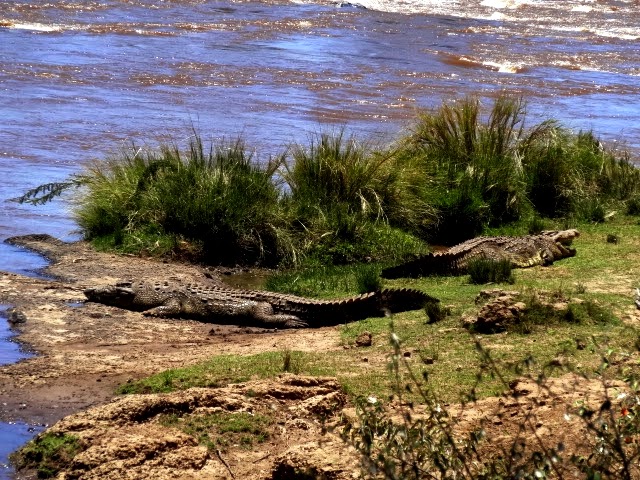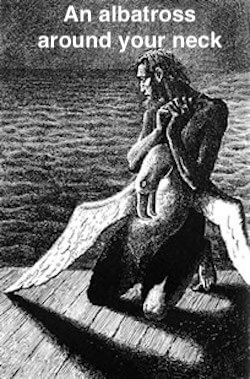 |
| The Cattana Wetlands offered excellent expansive views. |
 |
| Vegetation growing in the lake at the Cattana Wetlands created this view. |
Our sense of relief is totally wrapped around a high degree of excitement. We’ve filled the gap in our schedule for next June, July and August and couldn’t be more thrilled with the bookings we’ve finalized as of late last night.
 |
| There were numerous signs warning of the possibility of crocodiles as we entered the Cattana Wetlands, none of which we’ve seen as yet. |
In tomorrow’s post, we share the first half of the details with the balance the next day, each warranting their own post with the amount of information and photos we have to share.
As it turns out, we have an upcoming appointment on Tuesday morning at the Cairns Tropical Zoo to interview the Mammal Department Supervisor to learn about the zoo, the care, and preservation of the wildlife, and to take photos of the wildlife indigenous to Australia.
 |
| Who knows what creatures may lurk beyond the vegetation? |
OK, I get it. We’re hypocrites. We said that we “don’t do zoos” and normally we don’t. The reason we haven’t done so in the past is due to our love and respect for the preservation of animals in the wild. After all, we did go on many photo safaris in Africa in both Kenya and South Africa.
 |
| The sun reflected in the wetlands creating this orange glow in the water. |
However, we feel we could justify, rationalize or in less severe terms, simply explain, why we’re visiting a zoo on Tuesday to write a story about the facility, its operation, and the care for its vast array of Australian wildlife.
 |
| The Cattana Wetlands are well arranged with paved walking paths and clearly marked areas. |
Many moons ago, we spent days researching possible “safari-type” adventures in Australia, contacting many potential resources to get the same answer each time, “We don’t do safaris in Australia. You can drive to the Outback to possibly see some wildlife on your own.”
 |
| The various ponds and lakes were clearly marked. |
Frustrated that such a safari wasn’t realistic we gave up searching only to begin again once we arrived in Trinity Beach. After using no less than two gig of data searching online, again I came to the realization that its is not going to happen unless we rent an RV to make the trip on our own.
 |
| Peeking through the trees to the main lake in the Cattana Wetlands. |
Now, don’t get me wrong, we seriously considered touring the Outback on our own without fear or apprehension. We’d considered using the gap in our itinerary that we’ve since otherwise booked that we’ll present tomorrow and the following day.
 |
| Areas were clearly marked with maps and descriptions. |
The problem in touring the Outback on our own is the cost of the rental of an appropriate vehicle, preferably an RV with four-wheel drive (although not necessarily required) when hotels and RV parks, although available, aren’t as readily available as one may think.
 |
| We expected a beaver to pop up at any moment. |
The bottom line for us is the cost. A moderately sized and priced RV with toilet, shower, kitchen, etc. would cost in the range of US $15,000, AUD $19,954 a month when adding RV rental fees, fuel, groceries and RV park fees. The price of fuel alone would be outrageous when the cost here in Australia is twice as much, if not more, than the cost in the US.
 |
| This small island was located in the middle of the lake. |
In addition to the cost, we wouldn’t be able to get online and, most importantly, we may seldom find wildlife. The Outback is a vast desolate desert. One can drive for hours and hours to never see another vehicle.
 |
| A close up of lily pads on which some creature enjoyed lunch. |
Here’s an interesting article regarding some of the potential challenges of driving through the Outback.
 |
| The lakes were covered in parts in lily pads. |
Believe me, this has been a tempting prospect. But, reality prevails, and incurring this type of expense for that which may prove to be a very long drive in a vehicle with little to see, we decided against the possibility.
 |
| One of many paths we’ll explore when we return in the future. |
Instead, in this almost month we’ve been in Australia, we’ve wandered through many rainforest areas looking for wildlife including the Cattana Wetlands for over an hour (we’ll return again with insect repellent and proper clothing) we only saw a few birds, none of which we were able to get a photo.
 |
| It was especially appealing on a sunny day. |
As a result of this long and convoluted situation, we decided that the only way we’d see a large amount of indigenous wildlife would be to visit a zoo, one of which, The Cairns Tropical Zoo, is located near the Palm Cove area we visited a week or so ago.
 |
| Leave that have changed color. |
Contacting the Manager of Wildlife and Operations, we’ve been able to secure an appointment to interview a zoo supervisor to learn what we can about Australian wildlife which we’ll share here with photos and descriptions over a period of several days.
 |
| From a distance, we thought these were flowers when in fact, they were colorful leaves. |
Sure, we hesitated at this prospect based on our passion for animals in the wild. But, we both feel a tremendous desire to learn more about the exquisite and unusual inhabitants in the wild in this amazingly diverse continent. The only logical means of doing so with the least amount of expense and time is to take the path we’ve chosen, albeit with a bit of trepidation. Hypocrites? Perhaps. Wildlife enthusiasts? To a high degree!
 |
| As we entered the wetlands, this was the first path we took toward the lake. |
Today, we’re sharing the photos we took a few days ago at the Cattana Wetlands. Here’s a blurb of the story of the wetlands from this site:
“Originally a sugarcane farm owned by Franco Cattana, the site was used as a sand mining quarry resulting in several fresh and saltwater man-made lakes. The land was purchased by the then Mulgrave Shire Council in 1993, primarily to protect the 30 hectares of lowland rainforest on the western end of the site. This forest, described as the Feather Palm Forest, is a remnant of a once extensive forest type that is now confined to only a few remnant patches in the Cairns region. Council has planted over 70,000 native plants and undertaken extensive weed removal enabling existing water bird populations to flourish. As part of the 150th anniversary of Queensland celebrations, Council and the Queensland State Government each committed $1.5 million to the rehabilitation of the site. The works program included the construction of boardwalks, walking tracks, bird hides, and viewing platforms, picnic areas, interpretative signs, car parks, access roads, and toilet facilities. In addition to the amazing wetland habitat, Cattana Wetlands also harbours an impressive range of north Queensland wildlife and significant plant communities.”
Tomorrow, as stated above, we’ll be sharing our new bookings. Please stay tuned for much more to come!
Again, to our family and friends in the US, have a safe and memorable Fourth of July celebration.
Photo from one year ago today, July 4, 2014:
 |
| There are many tunnels on the island of Madeira, Portugal, located off the coast of Morocco in Africa. We enjoyed every day of the two and a half months we spent in a gorgeous house overlooking the hills and the sea. Also, on this date, one year ago, we posted our upcoming itinerary available at that time. Soon, we’ll be posting an updated itinerary, including the booking we’ll be sharing in the next few days. For more details, please click here. |






















































































































